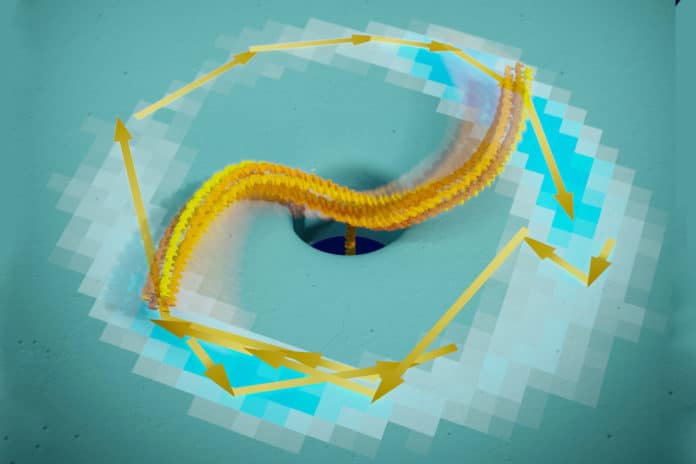Inspired by iconic Dutch windmills and biological motor proteins, scientists from the Delft University of Technology have developed the world’s smallest, self-configuring flow-driven motors from DNA. This flow-driven rotor converts energy from an electrical or salt gradient into useful mechanical work.
Dr. Xin Shi, a postdoctoral researcher in professor Cees Dekker’s lab in the Bionanoscience department at Delft University of Technology (TU Delft), said, “Rotary motors have been the powerhouses of human societies for millennia. These rotary motors, driven by a flow, also feature in cells that need to operate. But the synthetic construction at the nanoscale has thus far remained elusive.”
“Our flow-driven motor is made from DNA material. In a thin membrane, this structure is docked onto a nanopore, a tiny opening. The DNA bundle of only 7-nanometer thickness self-organizes under an electric field into a rotor-like configuration that subsequently is set into a sustained rotary motion of more than 10 revolutions per second.”
For 7 years, scientists have been trying to synthetically built such rotary nanomotors from scratch. In this study, scientists used a technique called DNA origami that uses the specific interactions between complementary DNA base pairs to construct 2D and 3D nano-objects.
The water and ion flow provide power for the rotors. This is established by applying voltage or, more simply, by having two sides of the membrane with differing salt contents. The latter is one of biology’s most abundant energy sources and fuels several crucial functions like cell propulsion and the manufacture of cellular fuel.
Scientists noted, “This achievement is a milestone, as it is the first-ever experimental realization of flow-driven active rotors at the nanoscale.”
Scientists were puzzled after observing the rotations: how could such simple DNA rods exhibit these nice, sustained rotations?
They solved the puzzle in discussions with theorist Ramin Golestanian and his team at the Max Planck Institute for Dynamics and Self-Organization in Göttingen. They found the fascinating self-organization process through a newly modeled system where the bundles spontaneously deform into chiral rotors that then couple to the flow from the nanopores.
She said, “This self-organization process truly shows the beauty of simplicity. But the importance of this work does not stop at this simple rotor itself. The technique and physical mechanism behind it establish an entirely new direction of building synthetic nanomotors: flow-driven nano turbines, a surprisingly unexplored field by scientists and engineers.”
“You would be surprised how little we knew and achieved building such flow-driven nano turbines, especially given the millennia-old knowledge we have on building their macroscale counterparts and the critical roles they fulfill in life itself.”
Scientists next made a significant advance: they designed the nanoscale turbine using knowledge obtained after developing a self-organized rotor.
She said, “Like how science and technologies always work, we started from a simple pinwheel, now can recreate the beautiful Dutch windmills, but this time with a size of only 25 nm, the size of one single protein in your body, and they demonstrated their ability to carry loads.”
Cees Dekker, who supervised the research, said, “And now, the rotation direction was set by the designed chirality. Left-handed turbines rotated clockwise; right-handed ones rotated anticlockwise.”
She said, “Next to better understanding and mimicking motor proteins such as FoF1-ATP synthase, the results open new perspectives for engineering active robotics at the nanoscale. What we have demonstrated here is a nanoscale engine that is truly able to transduce energy and do work. You could draw an analogy with the first invention of the steam engine in the 18th century. Who could have predicted then how it fundamentally changed our societies? We might be in a similar phase now with these molecular nanomotors. The potential is unlimited, but there is still much work to do.”
Journal Reference:
- Shi, X., Pumm, AK., Isensee, J. et al. Sustained unidirectional rotation of a self-organized DNA rotor on a nanopore. Nat. Phys. (2022). DOI: 10.1038/s41567-022-01683-z
